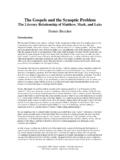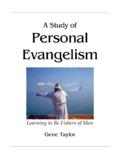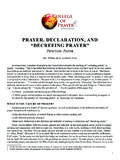Transcription of The Synoptic Gospels - Arizona Christian University
1 Arizona Christian University THE LITERATURE OF THE NEW TESTAMENT SUBMITTED TO MR. JOHN CORREIA IN PARTIAL FULFILLMENT OF BIB 497 BIBLICAL STUDIES INTERNSHIP BY ANDREW LINDERER 2 of 38 The New Testament The 27 books of the Bible known as the New Testament span a wide range of topics, genres, themes, and authors. It is important in the interpretation of these books to understand background information including geography, time period, audience, author, and purpose of writing. Without this information significant interpretive errors can and have been made. The purpose of this work is to give a brief overview of the New Testament in order to provide the reader with a basic understanding of the context of each book as well as significant interpretive issues found therein, thereby providing directions to more in depth resources for further study.
2 The Synoptic Gospels The Synoptic Gospels are Synoptic in that they share a majority of their information. Mark contains 93% shared information, matthew 58% and luke contains 41%.1 The gospel of John is the only gospel that is not considered part of the Synoptic Gospels because it is 92% peculiar, or dissimilar in its structure and makeup. The Synoptic Problem The Synoptic problem is the way that serious students of the Gospels attempt to understand the origins and interrelationships of the first three Gospels that will explain both the similarities and the differences .2 There are three main categories of theories that attempt to explain the amount of similarity as well as account for the apparent discrepancies in the Synoptic Gospels .
3 The first is the oral tradition view which attempts to explain the similarities in the Gospels by pointing out how rigidly first century Christians guarded their oral tradition. If oral tradition was as precise as we believe it to be then the word for word similarities among the Gospels can be explained very The second is the interdependence view which theorizes that the Gospels used each other as sources. The most common theory within this view is the Farrer Hypothesis which states that Mark was written first and then matthew used Mark to write his gospel , and luke followed and used both matthew and Mark. The final view is that there was at least one, if not more, Gospels written that have been lost.
4 This proto- gospel view, 1 Myers, Allen C., ed. " Synoptic Problem." The Eerdmans Bible Dictionary. 1997. Print. 976. 2 Bratcher, Dennis. "The Synoptic Problem: The Literary Relationship of matthew , Mark, and luke ." The Voice. CRI/Voice, Institute. Web. 08 Feb. 2010. < >. 2 3 Meyers, 976. 3 of 38 commonly held by more liberal scholars and referred to as Q, would explain the similarities in matthew and luke that do not exist in Mark. Others have theorized as many as three lost Gospels . While the proto- gospel would explain the similarities in matthew and luke quite well, conservative scholars tend to prefer the Farrer hypothesis.
5 matthew The authorship of the book of matthew is perhaps the most disputed historical question related to this gospel . 4 Church tradition has long accepted the apostle matthew as the author and many believe him to be one-and-the-same as the tax collector Levi. Others have argued to the contrary. According to Eusebius, matthew arranged or compiled the oracles in the Hebrew language or style. Some have argued then that the gospel we call matthew must have a different author because it is written in Greek. Others have made the argument that that Eusebius was referring to matthew s style which is Jewish or Hebrew in matthew was a tax collector, and the skillful organization of the book as well as the prominence of money and tax-collecting themes (10:3; 17:24-27; 18:23-25; 20:1-16; 27:3-5; 28:11-15) 6 seems to support the theory that matthew was the author.
6 None of the arguments for or against Matthean authorship are unassailable, but for Strauss, church tradition tips the scales in favor of matthew as the author of this gospel . The date of matthew is highly debated. Some opt for a late date in the 80 s or 90 s after the Temple was destroyed in AD 70 and point to 22:7 as a reference to the destruction of Jerusalem. Others believe that Mark was more likely the first gospel and believe that matthew 24:1-28 seems to point to the future of Jerusalem s destruction which would date the book in the early to mid 60 s. matthew s date, like the dates of many other Old and New Testament Books, remains obscure.
7 matthew is written specifically to Jews in order to explain and defend the deity of Christ. matthew contains a great deal of Old Testament prophecy fulfillment which the author 4 Strauss, Mark L. Four Portraits, One Jesus: an Introduction to Jesus and the Gospels . Grand Rapids, Mich.: Zondervan, 2007. Print. Pg 252. 5 Strauss, 252. 6 Strauss, 253. 4 of 38 intentionally points out to his Jewish audience in order to argue that Jesus truly was and is the matthew contains five major discourses, or sermons, of Jesus. The first discourse is found in chapter 5-7 and is referred to as the Sermon on the Mount.
8 The second is found in chapter 10 and deals with instructions to Missionaries. The third discourse is a collection of Parables found in chapter 13. The fourth deals with instructions for the community which include instructions for dealing with conflict in chapter 18. The fifth and final discourse is known as the Olivet Discourse which deals with eschatology and is found in chapters 23-25 (See Different Views of the Millennium chart on pg. 26). matthew also contains a genealogy of Christ in chapter 18 as well as Christ s discussion of divorce and remarriage in 19:1-12. Mark It is commonly accepted that the author of this gospel is John Mark, the cousin of Barnabus (Col 4:10) and follower of the Apostle Peter.
9 Some think that it is possible that he is the one who ran away naked the night Jesus was arrested (Mk 14:51-52).9 Those who agree with the Farrer hypothesis have no problem dating Mark in the early to mid 50 s AD, but a date in the late 50 s is acceptable as well. According to Gundry, If luke ends his book of Acts without describing the outcome of Paul s trial in Rome because the trial has not yet taken place, then Acts must be dated about 63, its preceding companion volume, the gospel of luke , somewhat earlier, and if luke s gospel reflects Mark Mark still earlier in the fifties or late forties. 10 Mark was most likely written to Gentiles. Mark explains many Jewish customs11 and translates many Semitic12 He also quotes from the Old Testament considerably less than matthew and luke and excludes the lineage of Christ.
10 7 Halley, Henry Hampton. Halley's Bible Handbook with the New International Version. Grand Rapids, Mich.: ZondervanPublishingHouse, 2000. Print. 578. 8 Also Found in luke 3:23-38. 9 Halley, 621. 10 Gundry, Robert Horton. A Survey of the New Testament. Grand Rapids, Mich.: Zondervan, 2003. Print. Pg. 128. 11 7:2-4; 15:42 12 3:17; 5:41; 7:34; 14:36; 15:34 13 Strauss, 202. 5 of 38 It is important when reading Mark to take a step back and examine the overarching theme of the book, namely, the defense of Christ. Mark focuses on the actions of Christ rather than the teachings of Christ in order to prove that Jesus was who he said he was.





